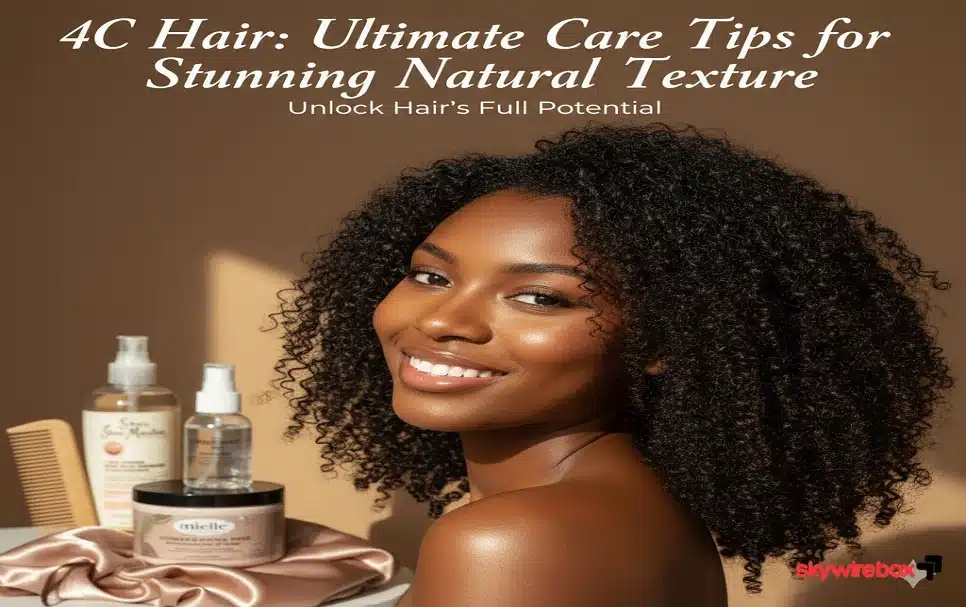If you have 4C hair, you know it’s unique, beautiful, and needs special care. This hair type features tight, coily curls that can sometimes look like a cloud or fro because the coils are so dense and defined differently from other hair textures.
You might struggle with dryness, shrinkage, or breakage, but with the right knowledge and routine, your 4C hair can thrive and shine. You’ll discover what makes 4C hair special, how to care for it, and the best styling tips to keep your curls healthy and vibrant.
Ready to unlock the secrets to loving your 4C hair every single day? Keep reading!
4c Hair Traits
4C hair has a very tight, zig-zag coil pattern. These coils are so small and dense that they often look like a cloud or fro. Shrinkage is very high, sometimes up to 70% of the hair length. This means the hair looks much shorter than it really is.
The texture is very fine but the hair feels thick because of its density. 4C hair has many strands packed closely together. This gives it a full and fluffy appearance.
Fragility is common in 4C hair. The tight coils make it prone to breakage and dryness. Common issues include split ends, breakage, and tangling. Extra care is needed to keep the hair healthy and strong.
Moisture Strategies
Hydrating products like leave-in conditioners and hair milks keep 4C hair soft. They add essential moisture without weighing hair down. Using water-based sprays can refresh curls throughout the day.
Deep conditioning routines once a week help restore dry, brittle strands. Choose conditioners with natural oils and butters. Cover hair with a plastic cap for 20 to 30 minutes to lock in moisture. This routine strengthens hair and reduces breakage.
Nighttime protection stops moisture loss while sleeping. Wrapping hair in a silk or satin scarf prevents friction and dryness. Using a satin pillowcase can also protect hair and keep curls intact.
Gentle Handling
Detangling4C hair requires patience and care. Use a wide-tooth comb or your fingers. Start from the ends and work your way up. Always detangle when the hair is damp and coated with conditioner. This reduces breakage and pain.
Protective styles like braids, twists, and buns help protect the hair. They keep the ends tucked away and reduce daily manipulation. This lowers the chance of damage and breakage.
To avoid breakage, avoid tight hairstyles that pull on the scalp. Keep hair moisturized with leave-in conditioners and oils. Always handle hair gently during styling and washing. Using a satin or silk scarf or bonnet at night helps keep hair healthy.

Product Selection
Ingredients like shea butter, coconut oil, and aloe vera help keep 4C hair soft and hydrated. Avoid products with heavy silicones or sulfates, as they can dry out tight coils. Natural oils such as jojoba and castor oil support scalp health and add shine.
Products designed for coily hair usually have extra moisture and gentle cleansers. Look for creams, leave-in conditioners, and butters that lock in hydration. Light oils help seal moisture without weighing hair down.
Custom routines work best for 4C hair. Start with a gentle cleanser, then apply a rich conditioner. Use a leave-in product and seal with an oil or butter. Adjust the steps based on your hair’s dryness and texture.
Regular Maintenance
Trimming hair every 6 to 8 weeks helps keep 4C hair healthy. It prevents split ends and breakage. Avoid trimming too often to allow growth. A small trim can remove damaged ends and make hair look neat.
Use gentle cleansing methods to keep 4C hair clean. Co-washing or sulfate-free shampoos work best. Wash hair once a week or less to keep natural oils. Rinse thoroughly to avoid product build-up.
Scalp care is very important for 4C hair health. Massage scalp gently with fingertips to improve blood flow. Use light oils like jojoba or tea tree oil to soothe dryness. Keep scalp clean and hydrated to prevent itching and flaking.
Styling Ideas
Low-manipulation styles help protect 4C hair from damage. These styles need less combing or brushing, which reduces breakage. Simple buns, twists, or braids work well. They keep hair neat and healthy.
Protective styles shield hair ends and reduce daily wear. Examples include box braids, cornrows, and wigs. These styles lock in moisture and help hair grow. They also save time on daily styling.
Enhancing natural texture means showing off your hair’s unique coil pattern. Use moisturizing creams and light gels to define curls. Finger coiling or twist outs bring out the hair’s natural shape without harsh tools.
Frequently Asked Questions
What Does 4c Hair Mean?
4C hair describes tightly coiled, dense curls with a zig-zag pattern and little visible definition. It shrinks significantly and needs intense moisture.
How Do I Know If My Hair Is 4a, 4b, Or 4c?
Identify 4a hair by its defined, springy S-shaped coils. 4b hair has a Z-shaped, less defined pattern. 4c hair shows tight, dense coils with minimal curl definition and significant shrinkage.
What Ethnicity Has 4c Hair?
4C hair is most common among people of African descent. It features very tight, dense coils with minimal definition.
What Is 5c Hair?
5c hair features very tight, dense coils with a zig-zag pattern, often appearing as a soft, voluminous cloud. It requires intense moisture and gentle care.
Conclusion
4C Hair is unique and beautiful with tight coils and lots of volume. It needs gentle care and regular moisture to stay healthy. Using protective styles helps reduce breakage and keeps hair strong. Sleeping with silk or satin prevents dryness and tangles.
Choosing the right products and trimming often supports growth and shine. Embrace your 4C hair with patience and love. Your natural texture deserves attention and respect every day. Our all updete get to visit our website: skywirebox









